Post updated 03/24/2024 – Dog parents, imagine stepping into your yard and finding it spotless – no unexpected messes, just a well-maintained garden and clean space for your kids to play. That’s the magic of having a dedicated outdoor dog potty area.
The best part is that creating such a space doesn’t have to be a daunting task. For the first potty area we created, we used a simple low fence and grass. For our most recent one we used 6×6 rail-road ties laying on the ground to outline the area, laid down a weed blocker then added mulch.
In this guide, I’ll provide a look at professional projects to draw inspiration from, along with easy-to-follow DIY tips to help you set up a functional and clean potty area for your dog.
Table of Content
Outdoor Dog Potty Area Inspiration Photos
Before we get into how to create a potty area in your yard, it’s always fun and useful to see what other people have done. Here we have a few projects that include dedicated dog potty areas and dog runs.
Custom Dog Run
In our first inspirational photo, the homeowners took our simple idea of dividing the yard a few (many) steps further. Here, they created a dog run on the side of their house while keeping the rest of their yard dog poop free.
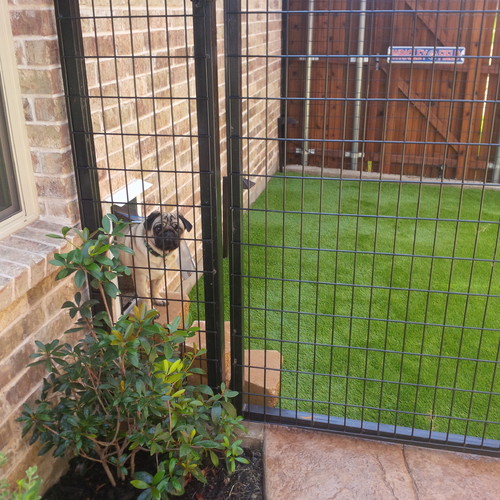
For easy access they added a doggy door with steps that leads out to the designated potty area from the house.
Below is another picture of the same yard. Here you can see how the backyard was divided between family space and potty space.

Small Side Yard
The next photo shows how the homeowners used the space between two structures to create a small dog run. Since it’s in a shaded area, they used artificial turf instead of real grass.
Our next inspirational photo shows a partially covered dog run. Although it is a small space it allows the dog the ability to get out to do their business no matter what the weather is like.
In this next dog run (see below), the homeowners wanted a larger area for their dog to run around. This customized space features a private doggy door and plenty of room for exploration. Synthetic turf keeps the area green and prevents dirt from being tracked into the home. This lucky pup also gets a great view of the lake.

How to Create an Outdoor Dog Potty Area
With the inspiration from the photos above, you’re probably eager to start creating your dog’s outdoor potty area. However, before diving into the building process, there are some important decisions to make.
Let’s take a moment to consider these key factors that will shape your project and ensure you create an effective and convenient space for your dog.
1. Where should your outdoor dog potty area go?
When deciding where to place an outdoor dog potty area, it’s a good idea to consider several factors, especially if you have larger dogs. Here are some points to keep in mind:
- Accessibility: The area should be easily accessible for your dog. For bigger dogs, ensure there’s ample space for them to comfortably move around.
- Smell – Although you should place it in an area with easy access make sure it’s not too close to outdoor living spaces. You don’t want your dog pooping right next to where you are having dinner.
- Proximity to the House: – consider its proximity to your house for convenience, particularly in bad weather or at night.
- Consider the climate: in snowy areas, keep it close to avoid shoveling long paths, and in hotter regions, choose a shaded spot to protect your dog from intense heat. Though it’s important that your doggy potty area gets some sun to assist in killing harmful and smelly bacteria.
- Garden Bed – Don’t place the potty area near or uphill from an edible garden. You don’t want to chance contaminating your garden with dog poo.
- Drainage Considerations: When setting up your dog’s potty area, it’s important to assess the gradient of your yard. Choose a location with effective drainage, ideally sloping away from your house and frequently used spaces.
Ideas on where to place your Dog Potty
A good option might be a side yard – Small side yards tend to be under-utilized making them a potential spot for a potty area. As you can see in the picture below, the narrow area was only previously used for the home’s utilities, but not much else would fit here. By adding artificial turf, good drainage and an in-ground dog septic system this area makes a convenient dog run.
2. How big should an outdoor dog potty area be?
The size of an outdoor dog potty area can vary depending on a few factors, primarily the size of your dog and the available space in your yard. If your dog is anything like mine, they need some space to walk around and smell the area before going. Here are some general guidelines to help you decide:
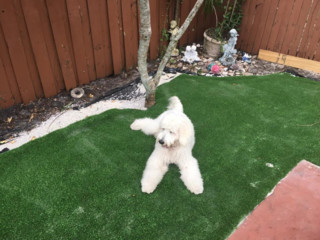
- For Small Dogs: A smaller area, around 6×6 feet or 6×8 feet, might be sufficient. Small dogs don’t require as much space to find a comfortable spot.
- For Larger Dogs: Bigger dogs will need more space to move around and find their preferred spot. An area of about 10×10 feet or even 12×12 feet is more appropriate for larger breeds.
- Multiple Dogs: If you have more than one dog, you should increase the size of the potty area accordingly to accommodate each dog’s needs and prevent crowding.
At a minimum the size of the dog potty area should at least allow your dog to comfortably turn a few circles before doing their business. It’s important to consider that a smaller space can become smelly faster, potentially deterring your dog from using it.
3. How will your dog access the potty area?
Another thing to think about is how you will access the potty area. Many of the inspirational photos we have provided include a dog door for easy access. While this will make it easier for your dog to go out on their own, you need to make sure the dog door is secure and your yard is safe.
4. What is the best ground cover to put in your outdoor dog potty area?

When selecting the best material for ground cover in an outdoor dog potty area, it’s important to choose options that are easy to clean, safe for your dog, and effective in controlling odors. Some great options to consider include:
1. Grass
Grass is the easiest and possibly cheapest ground cover for a doggy potty area. Plus, most dogs prefer grass. But it does have a few drawbacks. The most obvious one is the yellow urine stains that happen when the acid in dog urine kills the grass in your dog’s favorite pee spot.
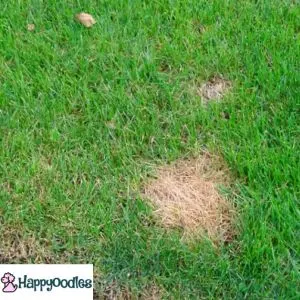
Now, there are products that will neutralize the acid but that means regular maintenance. In addition to the yellow spots, you will need to reseed the grass each season and mow regularly. Plus, if the grass dies you might be left with a poopy mud puddle.
It will also be harder to train your pup to only go in the potty area and not on the rest of the lawn.
Do dogs need grass to go to the toilet?
Dogs do not necessarily need grass to go to the bathroom. While many dogs are accustomed to relieving themselves on grass, they can be trained to use other surfaces as well. The key factors are training and the dog’s comfort.
2. Pea Gravel
Pea gravel is another good option as it provides good drainage and is comfortable for dogs to walk on. However due to its small size it can be easily washed away in the rain and you may find yourself picking up the gravel as you pick up the poop.
3. Mulch
Mulch is a good, inexpensive option. Much like the gravel, it drains well and looks nice.
But unlike gravel it will break down over time so you need to replenish it every year or two. We used wood chips in our first potty area. They worked out fine.

If you choose to use mulch in your potty area, look for undyed mulch. Also don’t use cocoa bean mulch or pine needle much as it is dangerous if ingested. Before selecting any mulch do your homework to make sure it will not harm your pup.
4. Artificial Grass
As you can see from our inspirational photos, artificial grass is a popular choice for dog potty areas, but it requires careful installation to be effective. Since it doesn’t absorb liquids, ensuring proper drainage is crucial to handle both urine and rainwater effectively.
Additionally, one should be mindful that artificial grass can heat up in warm weather or when directly exposed to sunlight, which might be uncomfortable for your dog.

5. Containment
Next step is to think about how you are going to keep your ground cover and maybe your dog contained in one spot.
There are several options based on your needs. If you are looking for more of a dog run then just a potty spot, a simple fence will do. In the dog run pictured below, they used wood posts and what appears to be deer netting to enclose the area.
You can see the dog door from the house in the middle of the picture.
Low fences will work fine for some dogs, but not all dogs are alike. We once had a dog that could climb chain-link fences.
Our next homeowners took the idea to the next level with this covered run. This dog run is located in Connecticut so weather was an issue.
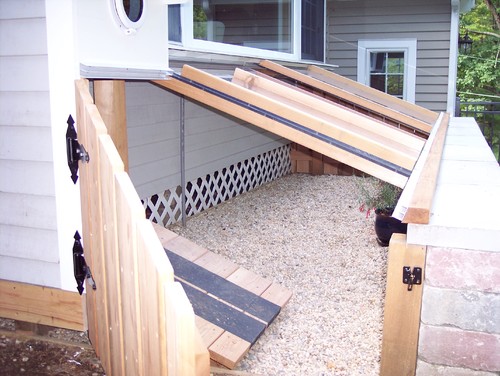
To combat the bad weather, they used glass windows to protect the potty area from the rain and snow while still letting light in. The windows can be opened on nice days to let in fresh air. There is also a dog door from the house.
6. Drainage
When deciding where to place your potty area, pay attention to how well the area drains. If the area does not drain well, you will need to add drainage or pick another location.
Driveway gravel works well for drainage. Just add a layer of gravel before adding the ground cover.
In the video below, they do a good job at showing what needs to be done to install artificial pet turf but the steps can apply to any ground cover.
How to Get Your Dog to Use the Potty Area?
Once you’ve set up your potty area, the next step is getting your pup to use it consistently. Fortunately, it’s not as daunting as it might seem. The process is similar to how you’d train a puppy to use pee pads indoors – it’s all about consistency and clear guidance. Here are some steps to ensure your dog quickly adopts the new potty area:
- Clean any existing poop from other areas of the yard to avoid confusion.
- Start your training first thing in the morning, when you know they need to go.
- Bring them to the potty area first thing in the morning. Give them the potty command and wait for them to go. Since they have not relieved themselves all night they will go quickly.
- Make sure to praise them for going in the potty area as soon as they start to go.
- Each time they go out bring them to the potty area before allowing them in the rest of the yard.
- If they do go in an area you don’t want them to, clean it up quickly.
With patience and persistence, your dog will soon be comfortable using their new designated space.
If your puppy is not potty trained yet, check out our post on Potty Training a Puppy: Made Easy. Here we let you in on our tips and tricks on how to potty train puppies. Our puppy potty trained in less than 2 weeks.

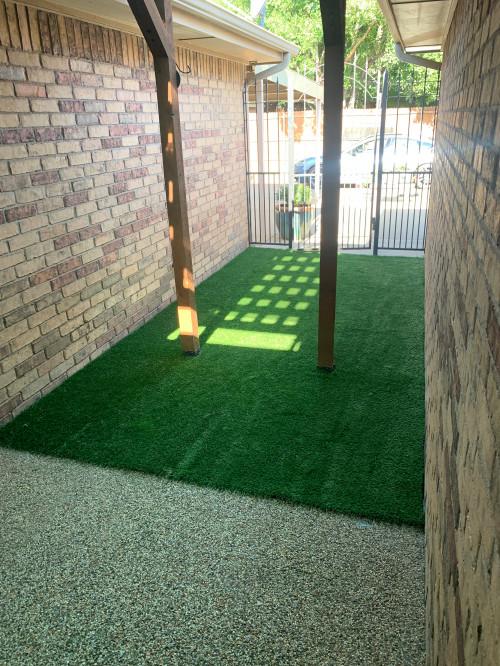
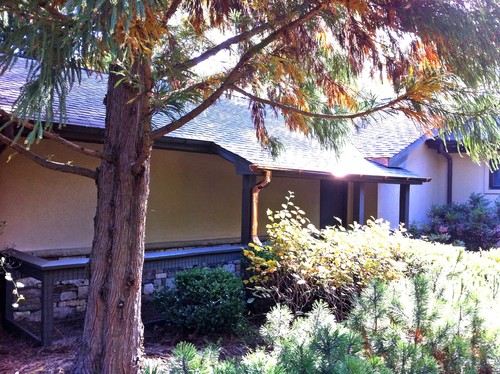





Mike
Monday 18th of December 2023
Here's a "next level" idea if you've got a little bit of money and/or you're designing a place from scratch. Build your potty area. And plumb it for a "squat toilet." If you don't know what a squat toilet is, just google it. But you can get one for $100 but it obviously needs to be installed. But put in a squat toilet in your dog's potty area. When the dog poops, you simply scoop it up and flush it down the toilet. Done! Gone! No lasting stink! No flies! You're not collecting piles of dog poop all week and then having to walk a big smelly bag of poop out to the curb for the trash man, etc. Also, if you're plumbing the toile, also install a small utility sink and a hose spigot...because you can NEVER have enough of those around. You're welcome. 😁
Janice
Monday 17th of April 2023
Thanks for the article, and thanks to everyone who commented. I've read that ammonia will entice dogs to pee. Would spraying ammonia in the potty area regularly also prevent a build up of the smells that eventually cause dogs to not want to use the potty area anymore?
Bonnie
Monday 17th of April 2023
Hi Janice,
Thanks for reaching out. Ammonia is toxic to dogs. Here is an article from PetMd that talks about the dangers of Ammonia and other cleaners. Common Cleaning Products That Can Harm Your Pets
Bonnie
Diana
Monday 18th of April 2022
I have two dogs. Will they both go in the same potty area?
Bonnie
Tuesday 19th of April 2022
Hi,
Thanks for stopping by. It will really depend on your dogs. Dogs like people have their own individual personalities, so it's impossible to know what they will do.
But most dogs want to go where another dog has already gone. Have you ever took your dog for a walk and they had to pee on every fire hydrant and post they see? That's because they smell another dog there.
So there is a good chance that they will use the same area. But two dogs using the same area will make the place dirty and smelly quickly. Although dogs want to go where others have gone, they don't want to step on poo. If it gets too smelly, even if you clean up all the poo, they will stop using it. Make sure you have a large enough area to accommodate both dogs.
Good luck
Bonnie
Rosanne Greco
Thursday 4th of November 2021
We live in northern Vermont and have a 12 pound, 8" tall Jack Russell Terrier. We have to shovel the snow in our back yard in order to get a spot for her to pee and poop. The photo of the CT leanto would work for us. We have a back deck on which we could attach it. Do you have (and/or can you sell us) the plans for building something like that. We do not want a glass top. All we are looking for is an enclosed area (without a floor) to block the snow (and rain).
Bonnie
Monday 8th of November 2021
Hi Rosanne,
If you click on the picture or the link right below it, you will be taken to Houzz.com. There you will find more pictures of the project and also information on the company that built it.
Good luck with the build.
Thanks for visiting our site.
Bonnie
Joan
Monday 12th of July 2021
We have a yellow lab rescue who up to 14 months, lived in a outdoor kennel. For the past year while living with us, he REFUSES to pee or poop in our outdoor run… it’s attached to our garage, it’s entered thru our back door, we stand there with him, and it has a river rock base. We’ve tried washing the area, putting in a fake hydrant, and nothing. HELP please!
Bonnie
Sunday 18th of July 2021
Hi Joan,
I would try replacing the rock with grass. Although my pup will go on concrete or gravel, she prefers to have a softer material to poo on. Since your dog wasn't trained to go on the rocks as a puppy he may never come around to the idea.
Best of luck Bonnie